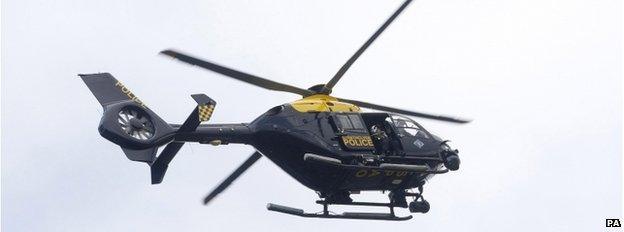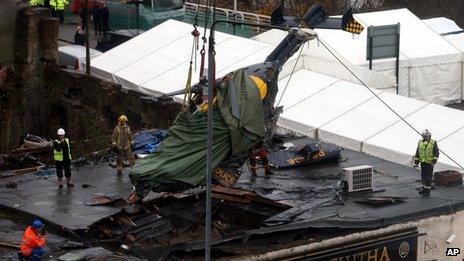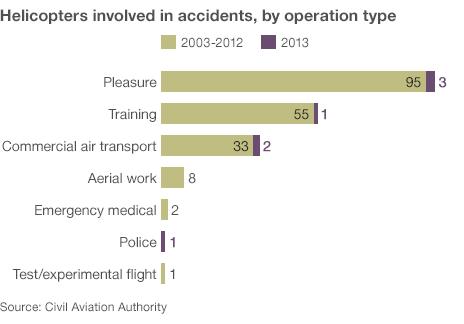Why do the police use helicopters?
- Published

Police Scotland's sole helicopter came down late on Friday night
The helicopter crash in Glasgow that killed nine people has shone a spotlight on the police's use of helicopters, considered an "essential tool" by officers on the front line. So how exactly do they help?
Helicopters are used for all sorts of reasons in the UK - from shooting films to transporting severely injured patients.
In a typical year, all of the registered helicopters in the UK fly a combined total of about 270,000 hours, according to the aviation regulator, the Civil Aviation Authority (CAA).
In particular, they have become an important part of the emergency services' kit, with 30 police helicopters and 36 air ambulances in operation in the UK.
And a police air service is available to 98% of the population of England and Wales within 20 minutes, the National Police Air Service (NPAS) says.
Issues with cost
Police forces usually turn to helicopters when there is no other alternative as they are expensive to operate, says David Learmount, from the aviation news website Flight Global.
But sometimes there is nothing else that can do the job, he insists.

The crash in Glasgow was the second aviation crash in a British city
"You cannot get away from a police helicopter. There is nothing like it for surveillance."
And helicopter pilot Richard Banham, who was trained by the British Army, says "helicopters' versatility really comes to the fore with the police".
As with the Police Scotland aircraft that crashed, the Metropolitan Police in London uses a three-man crew of a pilot and two police officers for its flights.
The Met's three helicopters are most commonly used to help officers on the ground search for suspects who are hiding, using thermal imagining equipment and a spotlight - according to its website.
And sometimes police officers on board take photographs - normally by leaning out of a door attached to a harness - to assist in the planning of operations and for use in court.
Helicopters are also useful during vehicle pursuits. By hovering above a chase and filming the scene below, the police's lead pursuit car is able to pull back from a suspect, helping to prevent any potential collisions, the Met says.
Technology is another important factor. Like other forces, Essex Police's helicopter has an automatic number plate recognition system that can read number plates and indicate any crimes associated with the vehicle.
Elsewhere, the aircraft can also help police to find missing people.
Dyfed-Powys police force says it can take 12 police officers 454 hours to search one square mile, at a cost of £4,500. But it says a police helicopter can do the same job in 12 minutes at a cost of just £160.
Despite this benefit, cost remains a big consideration.
The NPAS replaced localised police helicopter operations in England and Wales in 2012 in an attempt to cut the costs of running the air service from £63m a year to £48m a year, closing seven bases operating aircraft across county borders from 23 locations.
Despite the closures, Brian Greenslade of the Association of Police Authorities told the BBC air support remained an "essential tool" in the fight against crime.
Helicopter safety
A 2011 Freedom of Information (FOI) request by the Grimsby Telegraph, external shows it cost Humberside Police £1,600 per hour to operate its helicopter, prior to the NPAS forming.
And a 2010 FOI request suggests North Wales Police's helicopter cost a total of £1.7m to run over the course of a year.
The Met Police says its current annual budget to run its air support unit, including the maintenance of its three helicopters and staffing costs, is £7m.
In an effort to show what the helicopters are being used for, some air support units tweet what they are doing on a daily basis.
A recent tweet from the Met's team reveals it generally deals with 8,000 tasks per year, making it the country's busiest air support unit.

Safety is a high priority. Pilots who fly for the police are required to be very experienced and they are tested every six months.
"Helicopters have saved far more lives than they have ever taken," says pilot Richard Banham.
The crash in Glasgow is the only accident of any kind involving a police helicopter during the last decade, according to CAA figures.
Aviation expert David Learmount says it was only the second crash in a British city since aviation began.
The first, he says, was a crash in Vauxhall, London, earlier this year when a helicopter hit a crane, killing the pilot and a pedestrian.
Between 2003 and 2012 there were an average of nine fatal accidents for every million hours flown, according to the CAA. That figure is 13.2 so far for 2013.
Mr Learmount adds that while helicopters do have a worse safety record than planes, it is unfair to compare them because they are doing such completely different jobs.
There was a total of 201 accidents involving helicopters of all types between 2003 and 2013 - some 49% of which involved aircraft that were classed as being flown for pleasure.
Commercial air transport accounted for some 17% of all the accidents in the same period.
It is not helicopters that are dangerous but rather the jobs that they do, insists Mr Learmount.
Correction 4 December 2013: The Civil Aviation Authority has amended the figure it supplied for total helicopter flights from 27,000 hours a year to 270,000.
- Published2 December 2013
- Published2 December 2013
- Published1 December 2013
- Published1 October 2012